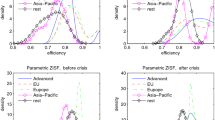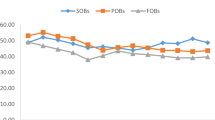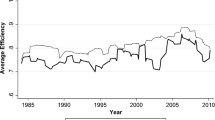Abstract
This paper deals with the estimation of market power, measured by the Lerner index, and cost efficiency at the bank level, using the stochastic frontier (SF) methodology. Both market power and cost efficiency are estimated jointly in a single step. We use the copula method to incorporate dependence between market power and cost efficiency. In contrast to earlier works that used a two-step approach, the SF approach used herein estimates a bank-specific nonnegative Lerner index free from random shocks. We showcase the advantages of our proposed methodology in terms of an empirical study on the banking sectors of five former communist countries during the period 2000–2008. Compared to the conventional approach, our model gives higher mean values of the Lerner index and smaller standard deviations. Further, we find a significant positive relationship between cost efficiency and market power of banks, thereby rejecting the “quiet life hypothesis.”

Similar content being viewed by others
Notes
The H-statistic has been popularly used as a direct measure of the degree of competition in the recent literature on bank competition. See for example, Bikker and Groeneveld (2000), De Bandt and Davis (2000), Bikker and Haaf (2002), Gelos and Roldós (2004), Claessens and Laeven (2004), Al-Muharrami et al. (2006), Casu and Girardone (2006), Staikouras and Koutsomanoli-Fillipaki (2006), Yeyati and Micco (2007), Turk-Ariss (2009), Carbó et al. (2009), and Delis (2010), among others.
See for example, Prescott and McCall (1975) for US banks; Shaffer (1993) for Canadian banks; Carbó et al. (2003) for Spain; Angelini and Cetorelli (2003) for Italian banks; Carbó et al. (2009), Fernández de Guevara et al. (2005, 2007), and Maudos and Fernández de Guevara (2004, 2007) for the cases of European countries; Berger et al. (2009) for the case of 23 different industrial countries; Turk-Ariss (2010) for developing countries; and Agoraki et al. (2011) for the case of 13 CEE transition countries.
Agoraki et al. (2011) claim that if the index is equal to 1, then the market is a pure monopoly.
This corresponds to a negative value of the H-statistic in the PR model.
Like the stochastic cost frontier, the stochastic output price frontier is defined as P = MC + noise which gives the minimum price that a firm charges without market power. The noise term is added to include possible measurement error in P.
They apply the model to study Taiwan’s hotel industry and simultaneously estimate two production frontiers, representing the technologies of accommodation and restaurant divisions of a hotel.
Note that the adjusted Lerner index proposed by Koetter et al. (2012) is expressed as \(L_{it}^\mathrm{adjusted} =(\mathrm{AR}_{it} -\mathrm{MC}_{it})/\mathrm{AR}_{it}\), where \(\mathrm{AR}_{it} \) denotes the estimated average revenue that is equal to the ratio of predicted total costs (TC) from (2) plus predicted total profits (TP) derived from an alternative profit function to total assets, i.e., \(\mathrm{AR}_{it} =(\mathrm{TC}_{it} +\mathrm{TP}_{it} )/\mathrm{TA}_{it} \).
This conditional expectation is \(E\left( {u_{1it} |\varepsilon _{1it}}\right) =\mu _{1^{*}it} +\sigma _{1^{*}} \frac{\phi \left( {-\mu _{1^{*}it} /\sigma _{1^{*}}}\right) }{1-\Phi \left( {-\mu _{1^{*} it} /\sigma _{1^{*}}}\right) }\), where \(\sigma _{1^{*}}^2 ={\sigma _{1u}^{2} \sigma _{1v}^2}/{\sigma _1^2}, \sigma _1^2 =\sigma _{1u}^{2} +\sigma _{1v}^2, \mu _{1^{*} it}=-\sigma _{1u}^{2}\varepsilon _{1it}/{\sigma _1^2}\), and \(\phi (.)\) and \(\Phi (.)\) are the PDF and CDF of the standard normal random variable, respectively (see Kumbhakar and Lovell 2000 for details).
In a non-competitive market, one can show that \(\mathrm{MR}=P\left( {1+1/e} \right) \), where \(e (\le 0)\) denotes the price elasticity of demand. By equating MC = MR, we obtain \(\frac{P-\mathrm MC}{P}=\frac{1}{-e}\), which relates the Lerner index to the price elasticity of demand.
There are several papers that impose regularity (monotonicity and concavity) conditions on a cost function (Griffiths et al. 2000; Terrell 1996) that can guarantee \(\mathrm{MC}\ge 0\). However, the Lerner index is implied by equation (4): \(P\ge \mathrm{MR}= \mathrm{MC}\), or equivalently, \(P-MC\ge 0\). Since P does not appear in the cost function, it is not clear whether the above inequality constraint can be directly imposed on the cost function of (2). Even if it is done, since \(P-MC\) can be affected by measurement error in P, it may not be appropriate to use the difference (normalized by P) to estimate the Lerner index.
For example, a large bank may decide to take predatory pricing to drive competitors out of the market.
The correlation in the composed errors may stem from (1) the correlation between \(v_{1}\) and \(v_{2}\), and (2) the correlation between \(u_{1}\) and \(u_{2}\). Unfortunately, we are unable to separate these two sources of correlation in our model. We would argue, in terms of our application, that \(v_1\) and \(v_2\) are not correlated because \(v_2\) represents noise in output price, whereas \(v_1\) is the noise in cost, and therefore, there may not be anything common between them. Since we are not certain on this, we investigate the nexus between market power and cost efficiency in Sect. 3.3 by testing the quiet life hypothesis.
The analysis can be easily generalized to cases with higher dimensions above two, which are more complicated and require more elaboration, as discussed in Aas et al. (2009).
See Chap. 4.8.1 of Cherubini et al. (2004) for a detailed description on the Gaussian copula. Amsler et al. (2014) point out an important feature of copula functions, i.e., they contain different range of dependence. The Gaussian, Frank, and Plackett copulas are comprehensive copulas, covering the entire range of dependence, while the Farlie–Gumbel–Morgenstern copula can model limited correlations, ranging between about −0.3 and +0.3.
Although this article assumes that the composed error terms are independent over time, the parameter estimates from such quasi-maximum likelihood (QML) estimation are consistent even when the dependence exists, so long as the likelihood for each observation is correctly specified. Note that the conventional standard errors are invalid and need to be modified. Based on (12), the standard ML estimator has the inverse of the Fisher information matrix \(I\left( {\varvec{\theta }} \right) =-E\left( \partial ^{2}\ln L\left( {\varvec{\theta }} \right) /\partial {\varvec{\theta }}\,\partial {{\varvec{\theta }}}' \right) \) as the covariance matrix of the estimator \({\hat{{\varvec{\theta }}}}\). The covariance matrix of the QML estimators has the so-called sandwich form: \(I^{-1}\left( {{\varvec{\theta }}}\right) E\left[ S\left( {{\varvec{\theta }}}\right) {S}'\left( {{\varvec{\theta }}} \right) \right] I^{-1}\left( {{\varvec{\theta }}}\right) \), where \(S\left( {\varvec{\theta }}\right) =\partial \ln L\left( {\varvec{\theta }}\right) /\partial {\varvec{\theta }}\) is the score function. Johnston and DiNardo (1997), pp. 428–430, provide a brief discussion of the QML estimation of misspecified models and the derivation of the covariance matrix.
Readers are suggested to refer to the appendix of Tsay et al. (2013) for a detailed derivation of \(I_\mathrm{app} (Q_i)\).
The monotonicity condition requires \(\partial \mathrm{TC}/\partial W_k \ge 0,\forall k\). The concavity condition requires the cost function to be concave in input prices, i.e., the Hessian matrix is negative semi-definite. Readers are suggested to refer to, e.g., Varian (1992), for those properties of the cost function.
The estimation results for the standard model are not shown to save space, but are available upon request from the authors.
Another possible explanation is that even though they have more or less market power, the incumbent banks might set their output prices close to the competitive level due to the risk of potential entrants, complying with the feature of a contestable market.
The parameter estimates of the alternative profit frontier are not shown to save space, but are available upon request from the authors.
The quiet life hypothesis posits that the higher a firm’s market power is, the lower is the effort by managers to achieve maximum operating efficiencies, and so there is a negative relationship between the degree of market power and managerial efficiency.
Most of the previous studies that tested the quiet life hypothesis mainly focus on banking systems in developed countries. For example, Berger and Hannan (1998) and Koetter et al. (2012) study US banking; Maudos and Fernández de Guevara (2007) and Delis and Tsionas (2009) examine European banking; Turk-Ariss (2010) explore the banking industries of 60 developing countries.
We also examine the association for each country and find the slope parameters to be positive and significant, ranging from 0.12 to 0.39, except for Latvia’s slope parameter estimate that is as low as 0.07 and insignificant. It is worth mentioning that if we regress the conventional measure of the Lerner index on technical efficiencies, then the estimate of the slope parameter is as low as 0.056, although significant at the 1 % level.
Maudos and Fernández de Guevara (2007) provide several reasons to explain this positive effect.
Berger and Hannan (1998) utilize the Herfindahl–Hirschman index to represent market power.
References
Aas K, Czado C, Frigessi A, Bakken H (2009) Pair-copula constructions of multiple dependence. Insur Math Econ 44:182–198
Agoraki MK, Delis MD, Pasiouras F (2011) Regulations, competition and bank risk-taking in transition countries. J Financ Stabil 7:38–48
Aigner D, Lovell CAK, Schmidt P (1977) Formulation and estimation of stochastic frontier production function models. J Econom 6:21–37
Al-Muharrami S, Matthews K, Khabari Y (2006) Market structure and competitive conditions in the Arab GCC banking system. J Bank Financ 30:3487–3501
Alegria C, Schaeck K (2008) On measuring concentration in banking systems. Financ Res Lett 5:59–67
Amsler C, Prokhorov A, Schmidt P (2014) Using copulas to model time dependence in stochastic frontier models. Econom Rev 33:497–522
Angelini P, Cetorelli N (2003) The effects of regulatory reform on competition in the banking industry. J Money Credit Bank 35:663–684
Beck T, Demirgüç-Kunt A, Levine R (2006) Bank concentration, competition, and crisis: first results. J Bank Financ 30:1581–1603
Berg SA, Kim M (1994) Oligopolistic interdependence and the structure of production in banking: an empirical evaluation. J Money Credit Bank 26:309–322
Berg SA, Kim M (1998) Bank as multioutput oligopolies: an empirical evaluation of the retail and corporate banking markets. J Money Credit Bank 30:135–153
Berger AN, Hannan TH (1998) The efficiency cost of market power in the banking industry. Rev Econ Stat 8:454–465
Berger AN, Demirgüç-Kunt A, Levine R, Haubrich JG (2004) Bank concentration and competition: an evolution in the making. J Money Credit Bank 36:433–451
Berger AN, Klapper LF, Turk-Ariss R (2009) Bank competition and financial stability. J Financ Ser Res 35:99–118
Bikker JA, Groeneveld JM (2000) Competition and concentration in the EU banking industry. Kredit Kap 33:62–98
Bikker JA, Haaf K (2002) Competition, concentration and their relationship: an empirical analysis of the banking industry. J Bank Financ 26:2191–2214
Carbó S, Humphrey D, Rodríguez F (2003) Deregulation, bank competition and regional growth. Reg Stud 37:227–237
Carbó S, Humphrey D, Maudos J, Molyneux P (2009) Cross-country comparisons of competition and pricing power in european banking. J Int Money Financ 28:115–134
Carta A, Steel MFJ (2012) Modelling multi-output stochastic frontiers using copulas. Comput Stat Data Anal 56:3537–3773
Casu B, Girardone C (2006) Bank competition, concentration and efficiency in the single european market. Manch School 74:441–468
Cherubini U, Luciano E, Vecchiato W (2004) Copula methods in finance. Wiley, New York
Claessens S, Laeven L (2004) What drives bank competition? Some international evidence. J Money Credit Bank 36:563–583
De Bandt O, Davis EP (2000) Competition, contestability and market structure in European banking sectors on the eve of EMU. J Bank Financ 24:1045–1066
Delis MD, Tsionas EG (2009) The joint estimation of bank-level market power and efficiency. J Bank Financ 33:1842–1850
Delis MD (2010) Competitive conditions in the central and Eastern European banking systems. Omega 38:268–274
Drakos K, Konstantinou P (2005) Competition and contestability in transition banking: an empirical analysis. Southeast Eur J Econ 2:183–209
Fernández de Guevara J, Maudos J, Pérez F (2005) Market power in European banking sectors. J Financ Serv Res 27:109–137
Fernández de Guevara J, Maudos J, Pérez F (2007) Integration and competition in the European financial markets. J Int Money Financ 26:26–45
Frees EW, Valdez EA (1998) Understanding relationships using copulas. N Am Actuar J 2:1–25
Fries S, Taci A (2005) Cost efficiency of banks in transition: evidence from 289 banks in 15 post-communist countries. J Bank Financ 29:55–81
Gelos RG, Roldós J (2004) Consolidation and market structure in emerging market banking systems. Emerg Markets Rev 5:39–59
Green WH (2003) Simulated likelihood estimation of the normal-gamma stochastic frontier function. J Prod Anal 19:179–190
Griffiths WE, O’Donnell CJ, Cruz AT (2000) Imposing regularity conditions on a system of cost and cost-share equations: a Bayesian approach. Aust J Agric Resour Econom 44:107–127
Joe H (1997) Multivariate models and dependence concepts. Chapman and Hall, London
Johnston J, DiNardo J (1997) Econometric methods. McGraw-Hill, New York
Jondrow J, Lovell CAK, Materov IS, Schmidt P (1982) On the estimation of technical inefficiency in the stochastic frontier production function model. J Econom 19:233–238
Koetter M, Kolari J, Spierdijk L (2012) Enjoying the quiet life under deregulation? Evidence from adjusted Lerner indices for U.S. banks. Rev Econ Stat 94:462–480
Koetter M, Poghosyan T (2009) The identification of technology regimes in banking: implications for the marker power-fragility nexus. J Bank Financ 33:1413–1422
Kumbhakar SC, Lovell CAK (2000) Stochastic frontier analysis. Cambridge University Press, Cambridge
Lai HP, Huang CJ (2013) Maximum likelihood estimation of seemingly unrelated stochastic frontier regressions. J Prod Anal 40:1–14
Lerner AP (1934) The concept of monopoly and the measurement of monopoly power. Rev Econ Stud 1:157–175
Mamatzakis E, Staikouras C, Koutsomanoli-Fillipaki N (2005) Competition and concentration in the banking sector of the South Eastern European region. Emerg Market Rev 6:192–209
Maudos J, Fernández de Guevara J (2004) Factors explaining the interest margin in the banking sectors of the European union. J Bank Financ 28:2259–2281
Maudos J, Fernández de Guevara J (2007) The cost of market power in banking: social welfare loss versus cost inefficiency. J Bank Financ 31:2103–2125
Meeusen W, Van den Broeck J (1977) Efficiency estimation from Cobb–Douglas production functions with composed error. Int Econ Rev 18:435–444
Nelsen RB (2006) An introduction to copulas. Springer, New York
Panzar JC, Rosse JN (1987) Testing for monopoly equilibrium. J Ind Econ 35:443–456
Prescott H, McCall A (1975) Market power and structure and commercial bank installment lending. J Money Credit Bank 7:449–467
Shaffer S (1993) A test of competition in Canadian banking. J Money Credit Bank 25:49–61
Shi P, Zhang W (2011) A copula regression model for estimating firm efficiency in the insurance industry. J Appl Stat 38:2271–2287
Sklar A (1959) Functions de répartition àn dimensions et leurs marges. Publications de l’Institut de Statistique de L’Université de Paris 8:229–231
Smith MD (2008) Stochastic frontier models with dependent error components. Econom J 11:172–192
Staikouras C, Koutsomanoli-Fillipaki A (2006) Competition and concentration in the new European banking landscape. Eur Financ Manag 12:443–482
Terrell D (1996) Incorporating monotonicity and concavity conditions in flexible functional forms. J Appl Econom 11:179–194
Tsay WJ, Huang CJ, Fu TT, Ho IL (2013) A simple closed-form approximation for the cumulative distribution function of the composite error of stochastic frontier models. J Prod Anal 39:259–269
Turk-Ariss R (2009) Competitive behavior in Middle East and North Africa banking systems. Q Rev Econ Financ 49:693–710
Turk-Ariss R (2010) On the implications of market power in banking: evidence from developing countries. J Bank Financ 34:765–775
Varian HR (1992) Microeconomic analysis. Norton and Company, New York
Yeyati E, Micco A (2007) Concentration and foreign penetration in Latin American banking sectors: impact on competition and risk. J Bank Financ 31:1633–1647
Yildirim HS, Philippatos GC (2007) Competition and contestability in central and Eastern European banking markets. Manage Financ 33:195–209
Author information
Authors and Affiliations
Corresponding author
Rights and permissions
About this article
Cite this article
Huang, TH., Liu, NH. & Kumbhakar, S.C. Joint estimation of the Lerner index and cost efficiency using copula methods. Empir Econ 54, 799–822 (2018). https://doi.org/10.1007/s00181-016-1216-z
Received:
Accepted:
Published:
Issue Date:
DOI: https://doi.org/10.1007/s00181-016-1216-z




